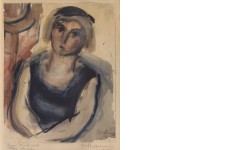TITΛΟΣ ΕΡΓΟΥJUNGE FRAU MIT BLOSSE ARME
ΔΙΑΣΤΑΣΕΙΣ ΕΡΓΟΥΎψος : 47
Πλάτος : 38
ΥΛΙΚΟ ΚΑΤΑΣΚΕΥΗΣΥδατογραφία (Υδατογραφία σε χαρτί)
ΥΠΟΓΡΑΦΗ ΚΑΛΛΙΤΕΧΝΗΚάτω Δεξιά
ΧΡΟΝΟΛΟΓΗΣΗ
ΕΛΕΓΧΟΣ ΓΝΗΣΙΟΤΗΤΑΣΔεν έχει ελεγχθεί

Provenance:
Private collection, Athens.
"These watercolours are true masterpieces!"1 the painter C. Polychroniadi exclaimed when she first saw Bouzianis' vibrant and insightful watercolours in October 1934. Likewise, in an essay prefacing the 1965 Bouzianis-Watercolours posthumous retrospective in Athens three decades later, art critic G. Mourelos argued that Bouzianis' watercolours constitute a monumental accomplishment in contemporary European art.2 Demonstrating swift rendering of the subject, fluid line and pulsating spread of colour, these precious jewels by the leading Greek expressionist had already made a strong impact in Germany as early as the late 1920s. Reviewing the artist's 1928 exhibition at Barchfeld's in Leipzig, Dr. H. Hofmann argued that Bouzianis' watercolours confirm his status as one of the greatest artists of his time3, while, on the occasion of the painter's 1932 show, the art critic M. Schwimmer remarked: "Employing the most frugal means he conveys powerful and insightful impressions, a sense experience of form and colour more intense than any offered by even the best watercolours by Nolde or Kirchner."4
Junge Frau mit blosse Arme perfectly illustrates these cogent points. Here, the element of distortion, a defining trait which usually plays a dramatic role in expressionism, is kept on a very tight rein. The artist avoids sentimentality and pathos, or indeed any theatrical device which might charge his forms with too obvious a pitch of heightened feeling. There are no grotesque excesses, no falsification whatsoever of the subject's essential integrity. Yet, this brilliant work of unforced clarity is full of strong feeling (notice how astutely the young woman's eyes are captured in a highly reductive fashion), marvellously disciplined by artistic intelligence and continuously subordinate to aesthetic demands, achieving unity of content and technique in such a masterly way that even the artist's signature becomes an integral element of the work.5
As perceptively noted by the painter C. Botsoglou, "Bouzianis' signed mats seem to be extending rather than framing his watercolours, becoming one with his pictures. Such paintings are born and raised naturally, like children or trees and have a life of their own, not by imitating nature but, rather, as integral parts of the aesthetics of nature. In this kind of painting it is probably inappropriate to distinguish between design, colour, material and space. They are all one... One of Bouzianis' favourite subjects is the female figure, a human presence inseparably linked with pictorial adventure. What I mean to say is that the intensity in Bouzianis' work does not derive from the expressiveness of faces and bodies, a fact that differentiates him from the mainstream of German Expressionism. His figures are emotionless, showing no expressive facial contortions. The expressive thrust of this type of painting relies exclusively on pictorial means."6
The seated woman, with her voluminous limbs and corporeal presence, fills the surface of the painting with her statuesque calm, generating a tension between bodily volume and pictorial space in the vein of Picasso's 'classic phase' in the 1920s, where the artist's predilection for plastic volumes in the treatment of the human figure was revived by his exposure to Greco-Roman sculpture. As keenly noted by Y. Tsarouchis, "there is something classical in the works of Bouzianis, because for a Greek the classical is a natural state of mind."7 Elaborating on this remark in his recently published collection of essays, Y. Psychopedis notes: "Though he had assimilated the radical extremities of expressionism, Bouzianis transformed their pronounced gothic metaphysics to a discourse regarding the living human subject. His figures are tied to reality; they are not alienated as formless matter neither lose their identity becoming abstract, archetypal forms or nightmarish masks... His work emanates a nostalgia for the classical, a nostalgia for a lost and constantly sought balance."8 However, in contrast to the sharp profiles on ancient Greek vases, the frontality of the portrait is akin to the perception governing Byzantine icon painting,9 endowing it with a symbolic dimension as if it were the image of a modern saint.
1. Ikastika magazine [in Greek], no. 2, February 1982, p. 15.
2. See G. Mourelos, preface to Bouzianis-Watercolours (exhibition catalogue), Greek-American Union, Athens, February 1965.
3. H. Hofmann, Leipziger Abendost daily, 6.9.1928
4. MS, Leipziger Volkszeitung daily, 23.12.1932.
5. See Mourelos.
6. C. Botsoglou, 'Reflections on the Work of G. Bouzianis - A Confession' [in Greek], Anti journal, no.302, 25.10.1985.
7. Y. Tsarouchis, preface to Bouzianis-Watercolours [in Greek], Agra-The Friends of Bouzianis publ., Athens 1982, p. 12.
8. Y. Psychopedis, The Militant Introversion, Expressive Lyricism and Critical Spirit in the Work of Bouzianis [in Greek] in Nostos, Kedros publ., Athens 2009, pp. 228-229.
9. D. Deliyannis, Bouzianis [in Greek], Adam publ., Athens 1996, pp. 38, 39, 99.